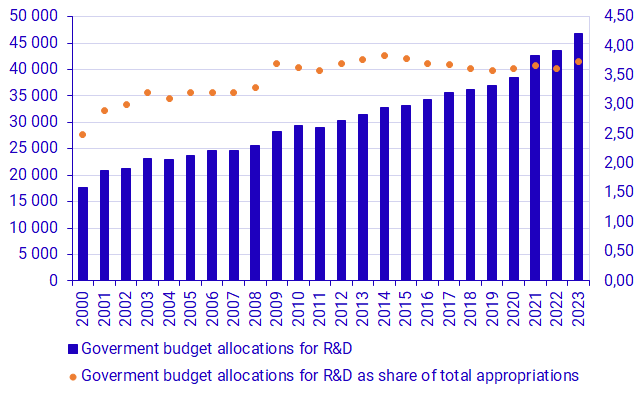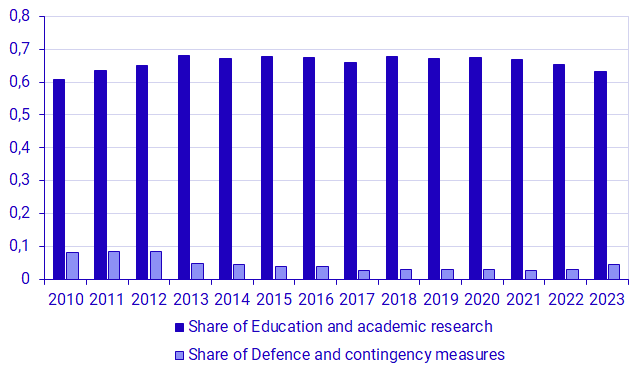Government budget allocations for R&D (GBARD) 2023
Government budget allocations for R&D 2023
Statistical news from Statistics Sweden 2023-03-30 8.00
Central government budget allocations for R&D are expected to rise in 2023 and amount to SEK 46.8 billion, corresponding to 3.74 percent of the total Central government budget.
The central government’s funding of research and development (R&D) based on budget appropriations gives an early indication of its priorities in the research area. The funds are not actual expenditures on R&D reported by performers, but budgeted funds for R&D financed by the central government. In addition to giving an indication about the central government’s priorities, it also provides early insights into the R&D activities at, for example, universities and other tertiary level education institutions that are financed by funds from central government budget.
Statistics Sweden estimate that SEK 46.8 billion in the central government budget will be allocated to R&D in 2023. Compared to 2022, this is an increase of SEK 3.31 billion or 7.6 percent. A change in the survey method is estimated to account for just under SEK 1.46 billion of the increase. For more information about the change, see the last part of this statistical news and the survey's documentation.
Funds for R&D as a share of total funds in the central government budget have been relatively constant since 2011. Since the year 2000, the share has increased by 1.24 percentage points from 2.50 to 3.74 percent in 2023 with a peak in 2014 of 3.84 percent. The largest increase in recent years occurred in 2021, when estimated R&D funds rose by 11 percent compared to 2020. This may be an effect of the corona pandemic, as the largest increase in total appropriations in the central government budget since 2000 was also noted, 9.7 percent in 2020. That R&D funds increased relatively more than the total appropriations is because the increase mostly occurred in research grants or grants that are partially used for R&D. After 2021, Statistics Sweden calculates that the higher level, which was the result of the increase during the pandemic, will remain and even increase somewhat further.

Reduced share of budget allocations for R&D to higher education institutions in 2023
Government budget allocations for R&D are distributed according to the socioeconomic objectives of the R&D funds, which shows the central government’s priorities. R&D funding allocated to the General advancement of knowledge: R&D financed from General University Funds (GUF) still constitutes the largest objective. In 2023, Statistics Sweden estimate that the government will allocate SEK 21.5 billion to R&D at universities and other tertiary level education institutions via their general block grants. This is an increase of 555 million since 2022 in current prices. As a share of total budget allocations for R&D, R&D funding financed from GUF makes up 46 percent, which is a decrease since the previous year and the lowest share since 2011. According to Statistics Sweden's calculations, all fields of research and development will receive increased funding in 2023 except social sciences and humanities.
| Breakdown by fields of research and development | 2022 | 2023 |
|---|---|---|
| R&D related to Natural sciences | 4 867 | 5 211 |
| R&D related to Engineering Sciences | 3 190 | 3 268 |
| R&D related to Medical Sciences | 6 357 | 6 489 |
| R&D related to Agricultural Sciences | 1 178 | 1 263 |
| R&D related to Social Sciences | 3 368 | 3 349 |
| R&D related to Humanities* | 1 962 | 1 897 |
| Total | 20 922 | 21 477 |
*The arts are included
Increased R&D funding in several expenditure areas
Like previous years, the expenditure area Education and academic research accounts for most of the R&D funds, at SEK 29.6 billion in 2023. In addition to the general block grants for tertiary level education institutions, the expenditure area also includes other appropriations with funds allocated to R&D, which is the reason why the sum does not correspond to the R&D funds above. Since 2010, the percentage has varied between 60.9 and 68.1 percent, but after observing an upward trend 2010 and 2015, it has since turned downward, and the percentage is estimated to 63.2 percent in 2023.
Budget allocations to R&D in the expenditure area Defence and contingency measures is expected to increase by SEK 820 million in current prices or 62.4 percent compared to 2022. The increase is an effect of the change of survey method. During 2010–2012, R&D funds for the expenditure area constituted just over 8 percent of the total budget allocations to R&D and then decreased and averaged 3.5 percent until 2023, when the share increases to 4.6 percent. In relative terms, the expenditure areas Financial security for those with illnesses and disabilities and Regional development also increase as an effect of the change in survey method. Financial security for those with illnesses and disabilities increases from 8.9 million to 39.4 million, while regional development increases from 323.4 million to 858.6 million.

Facts
The statistics are preliminary and are based on the content of the provisional central government budget.
The survey follows guidelines set up by the OECD and published in the Frascati Manual, Guidelines for Collecting and Reporting Data on Research and Experimental Development, Frascati Manual (OECD, 2015). These statistics are also subject to the Commission Implementing Regulation (EU) No 2020/1197 of 30 July 2020. The data is submitted to Eurostat, who produces compilations for the EU countries.
New survey method in 2023
As of the reference year 2023, the statistics have a new design. The survey is now based on administrative data and coefficients used on each budget item to calculate the R&D content. The method leads to somewhat increased R&D funds. For total government budget allocations for R&D, the survey method change is estimated to account for just under SEK 1.46 billion of the increase compared to 2022.
Definitions and explanations
Research and experimental development (R&D) comprise creative and systematic work undertaken in order to increase the stock of knowledge – including knowledge of humankind, culture and society – and to devise new applications of available knowledge.
For an activity to be an R&D activity, it must satisfy five core criteria. The activity must be:
- Novel
- Creative
- Uncertain
- Systematic; and
- Transferable and/or reproducible
Next publishing will be
The next statistical news in this series will be published in March 2023.
Feel free to use the facts from this statistical news but remember to state Source: Statistics Sweden.
